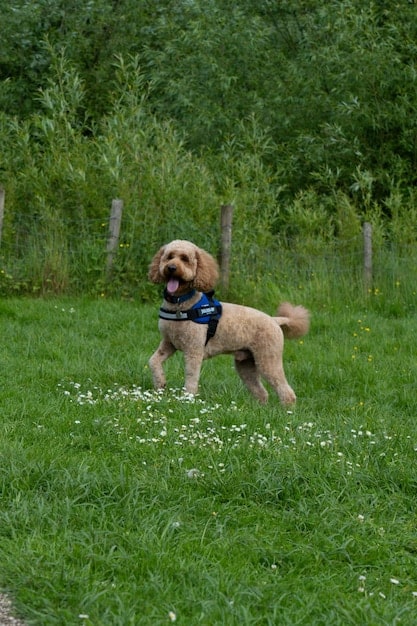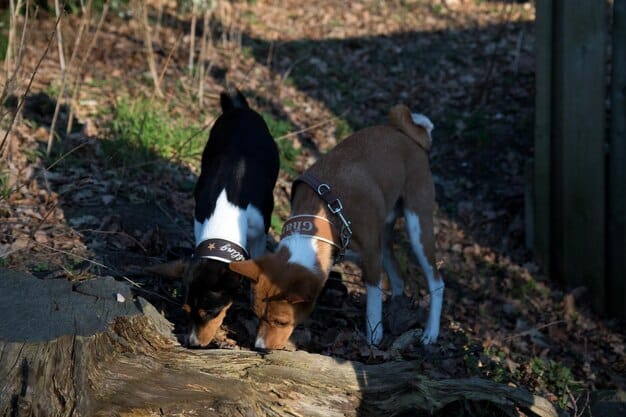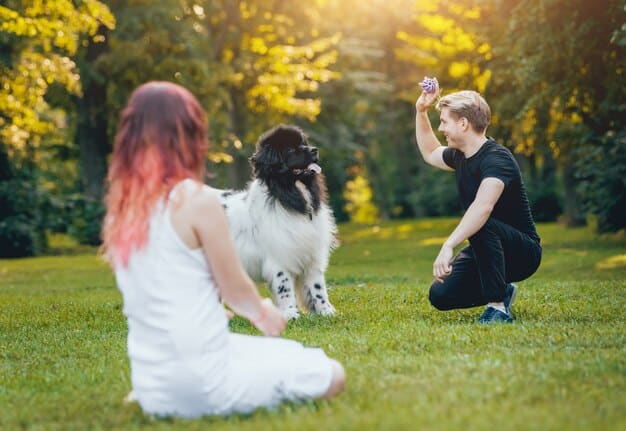Dog Park Etiquette: Training Your Dog for Safe Social Interactions

Dog park etiquette encompasses a set of guidelines and practices designed to ensure safe, positive, and enjoyable experiences for all dogs and their owners by promoting responsible behavior, preventing conflicts, and fostering a harmonious environment within the dog park setting.
Navigating the dog park can be a fun experience for both you and your furry friend. Understanding and practicing proper dog park etiquette: training your dog for safe and social interactions ensures a harmonious environment for everyone involved.
Understanding Dog Park Etiquette
Dog parks are amazing places for dogs to socialize, exercise, and have fun. However, they can also be sources of stress and potential conflict if owners and their dogs don’t follow some basic rules. Learning dog park etiquette isn’t just about being polite; it’s about ensuring the safety and well-being of all the dogs and people present.
Why Etiquette Matters
Etiquette in a dog park serves many purposes. It prevents fights, reduces the spread of disease, helps fearful dogs feel more comfortable and encourages responsible dog ownership. When everyone knows what is expected, the dog park can become a place to enjoy watching your dog have fun.
- Safety: Prevents aggression, injuries, and keeps all dogs safe.
- Health: Reduces the risk of disease transmission through responsible practices.
- Social Harmony: Creates a welcoming environment for dogs and their owners.
The knowledge and application of dog park etiquette will ensure a friendly and secure environment for both dogs and their owners, making every visit a great experience.

Pre-Park Training and Preparation
Before you even consider taking your dog to a dog park, you must make sure your dog knows basic obedience commands and has the proper temperament. Walking into the park with an untrained dog can be a recipe for disaster.
Basic Obedience Training
Your dog should reliably respond to commands such as “sit,” “stay,” “come,” and “leave it.” These commands can be invaluable in managing your dog’s behavior and preventing potential conflicts. Regular training sessions at home and in various environments can help reinforce these commands.
In addition to formal obedience classes, daily training exercises can make a big difference. Use positive reinforcement techniques, such as treats and praise, to motivate your dog and make learning fun.
Health and Vaccination Requirements
Most dog parks require dogs to have up-to-date vaccinations, including rabies, distemper, parvovirus, and kennel cough. You may need to provide proof of vaccination before entering the park. Regularly deworm and protect against fleas and ticks.
- Vaccinations: Ensure all shots are up-to-date and provide proof if required.
- Parasite Control: Protect against fleas, ticks, and worms.
- Health Check: Make sure your dog is free from communicable diseases before visiting.
Getting your dog fully prepared before entering the park means they will stay safe and also protect other dogs from potential sicknesses.
Introducing Your Dog to the Park
The first visit to the dog park can be a big step for both you and your dog. A gradual and careful introduction can lead to long-term positive experiences. Observing how your dog interacts with other dogs outside of the park can provide insights into how they might behave inside it.
Initial Visit Strategies
Start by visiting the park during off-peak hours when fewer dogs are present. This will give your dog time to acclimate to the surroundings without being overwhelmed by a large group. Enter the park with your dog on a leash and observe their behavior. Watch how they respond to other dogs approaching and how they handle the new environment.
If your dog seems relaxed and curious, let them off the leash. If they appear anxious or fearful, keep them on the leash and slowly introduce them to a few calm dogs.
Reading Dog Body Language
Understanding canine body language is essential for ensuring positive interactions. Signs of a relaxed and happy dog include a wagging tail, loose body posture, and play bows. Conversely, signs of stress or aggression include a stiff posture, raised hackles, growling, and bared teeth. Watch your dog closely for these signals and be prepared to intervene if necessary.
- Relaxed: Wagging tail, play bows, relaxed posture.
- Stressed: Stiff posture, raised hackles, growling.
- Intervene: Separate dogs showing signs of aggression or discomfort.
Learning the body language of dogs can protect your dog and other dogs in the park. Responsible dog owners are always watching for cues that represent positive or negative interactions.

Managing Interactions Inside the Park
Once inside the dog park, your role as a responsible owner is far from over. Managing your dog’s interactions with other dogs is incredibly important to keep the dogs safe.
Supervising Play and Preventing Fights
Supervision is key to preventing fights. Always keep an eye on your dog and be ready to intervene if play escalates into aggression. Pay attention to the overall dynamics of the group as well.
Understanding the difference between friendly play and aggressive behavior is crucial. If a fight does break out, remain calm and try to separate the dogs using a loud noise or by pulling them apart by their hind legs. Never reach into the middle of a fight, as you could get bitten.
Dealing with Dominance and Resource Guarding
Dominance is a natural part of dog behavior, but it can lead to problems if not managed properly. Resource guarding, such as protecting toys or food, can also cause conflicts. If your dog is displaying dominant behavior or guarding resources, redirect their attention or remove the item causing the conflict. It is important to recognize the signs of dominance early to manage the interactions properly.
Redirecting attention and removing the item are effective ways to deal with dominance and resource guarding to protect everyone and keep the experience a positive one.
Responsible Owner Behaviors
Besides managing your own dog, responsible behavior as an owner also involves being considerate of other dogs and owners in the park. This means following the rules and making sure the park remains clean and accessible.
Following Park Rules
Most dog parks have specific rules posted at the entrance. These rules may include leash requirements, age and vaccination restrictions, and guidelines on bringing food or toys. It is important to familiarize yourself with these rules and follow them carefully. Disregarding park rules can lead to conflict and compromise the safety of others.
Following park rules shows respect for other dog owners and ensures a fun experience for all.
Cleaning Up After Your Dog
One of the most basic yet vital aspects of dog park etiquette is cleaning up after your dog. Always carry poop bags and promptly dispose of any waste your dog leaves behind. Leaving waste uncollected is not only inconsiderate but can also spread disease and make the park unpleasant for everyone.
- Carry Bags: Always have poop bags with you.
- Prompt Disposal: Clean up immediately after your dog.
- Littering: Dispose of bags in designated trash cans.
Cleaning up after your dog is essential for hygiene and for showing respect to the other people using the park.
When to Leave the Dog Park
Knowing when it’s time to leave the dog park is just as important as knowing how to behave while you’re there. Sometimes, the best thing you can do for your dog and the other dogs at the park is to simply pack up and go home.
Recognizing Signs of Overstimulation or Stress
Dogs can become overstimulated or stressed in a dog park environment. Some signs of overstimulation include excessive barking, mounting, or inability to focus. Signs of stress may include panting, lip licking, whale eye (showing the whites of the eyes), and attempts to hide. If you notice these signs, it is best to leave the park to prevent your dog from becoming overwhelmed or aggressive.
Sometimes, taking a break from the park to decompress can be the best solution. After leaving the park, allow your dog to relax and recover in a calm environment.
Handling Negative Experiences
Not every visit to the dog park will be perfect. If your dog has a negative experience, such as being bullied or involved in a fight, it is important to address the situation calmly. Leaving the park immediately can help prevent further escalation and allow your dog to decompress. Consider seeking advice from a professional dog trainer or behaviorist if your dog consistently has negative experiences at the park.
Assessing the reason for the bad experience and thinking about steps to mitigate the chances of reliving it ensures the long-term happiness and balance of your dog.
| Key Element | Brief Description |
|---|---|
| 🐾 Training | Ensure your dog knows basic commands like “sit,” “stay,” and “come.” |
| 💉 Health | Keep vaccinations up-to-date and protect against parasites to prevent disease spread. |
| 👀 Supervision | Always supervise your dog and be ready to intervene if behavior escalates. |
| 💩 Cleanliness | Always clean up after your dog and dispose of waste properly. |
Frequently Asked Questions
▼
Most dog parks require dogs to be vaccinated against rabies, distemper, parvovirus, and kennel cough. Always check the specific requirements of the dog park you plan to visit.
▼
Redirect your dog’s attention away from the resource by calling their name and offering a treat. If necessary, remove the item causing the guarding behavior to avoid conflicts.
▼
Signs of overstress include panting, lip licking, whale eye (showing the whites of their eyes), flattened ears, and attempts to hide or escape the environment.
▼
Stay calm, and try to separate the dogs by making a loud noise or pulling them apart by their hind legs. Never reach into the middle of a fight to avoid getting bitten.
▼
It depends on the dog park’s rules. If allowed, use treats carefully, as they can sometimes cause resource guarding conflicts. Always ask other owners before giving treats to their dogs.
Conclusion
Dog park etiquette is essential for ensuring a safe, fun, and positive experience for all dogs and their owners. By following these guidelines, you contribute to creating a welcoming environment where dogs can socialize and play responsibly.





